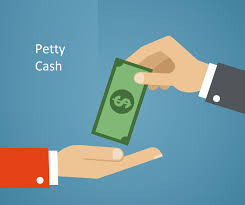
Not every business expense can be easily paid with a check or company credit card. Small, one-off purchases like a meal or snack for a meeting, stamps, or any other small last-minute expense may be much easier to pay with cash. Hence, the petty cash fund.
Petty cash is kept on hand to cover these expenses and is often somewhere between $100 and $500 depending on the size of the business and how often petty cash is needed. But even thought petty cash is small, it can be a big risk for misuse or even theft if you don’t have a solid petty cash management system in place.
Here are a few best practices and internal controls to make your petty cash easier to manage and more secure:
Who’s in Charge Here?
Petty cash shouldn’t be a wad of bills in a jar. That opens you up to all kinds of problems. Unless, of course, that jar is inside a locked safe; then have at it.
Petty cash should be kept in a secure location like a lock box or a locked file cabinet drawer. Access to that drawer should be limited to an assigned custodian who’s responsible for petty cash, plus the controller, CFO, or business owner. Any requests for petty cash need to go through the custodian and that person is responsible for recording and tracking the cash properly.
When choosing a custodian, make sure it’s not the same person who will record the petty cash transactions in the general ledger at the end of the month. This provides an extra level of security and separation of duties so no one can dip their hand in the cookie jar and cover it up in the books.
In a larger company, you may need to keep petty cash in each department or location and assign a custodian for each area. After all, the point of petty cash is to be at least somewhat convenient when you need it.
How Much Do You Need and What Is It For?
Earlier, we mentioned a typical range of $100 to $500 for petty cash. It really depends on your needs and the size of your company. If you use petty cash frequently, you may want to keep more on hand.
Replenishing petty cash is as simple as cashing a check and placing the cash in the fund, but if you need to cut checks several times a month, it undoes the convenience of a petty cash fund. You should have enough cash on hand to last the month, but preferably not much more. That way you don’t have to constantly replenish the fund but you minimize the risk and temptation for someone to try and steal cash.
You should also establish standards for petty cash, in terms of what it can be used for. The appropriate use of petty cash should be known to the employees, and especially to the custodian of the fund, since he or she will be the one disbursing cash on request. As yourself these questions:
- What types of purchases is petty cash intended for?
- How much petty cash can be used at once?
- Do certain purchases require a prior approval from someone other than the custodian?
- Are receipts required for every petty cash purchase or those above a certain dollar amount?
- The answers to these questions will form the basis of your petty cash policy.
Documenting Petty Cash Use
Each time a withdrawal is made from petty cash, the custodial needs to document it according to the policy. A simple way to do this is to keep a ledge book along with the petty cash and create an entry each time cash is added or removed. Bookkeeping will then use this ledger to enter transactions into the general ledger each month.
Your petty cash ledger entries should include:
- Date
- The vendor who was paid
- The employee who made the transaction
- A description of what was purchased
- Amount
- Running total for the month
This gives the bookkeeper everything they need to enter into the general ledger and provides a clear picture of what petty cash is used for. It also provides accountability. In some cases, you may wish to have the employee using the petty cash sign the ledger as well. If receipts are required, have the employee bring them back after the purchase and attach them to the ledger book.
Reconciliation
As with any account, regular reconciliations are needed to make sure things are as they should be. To reconcile petty cash, start with the beginning balance and use the current cash in the box as the ending balance. This is easiest at the end of the month. The difference should match the entries is the ledger book and accompanying receipts if required. The custodian will need to account for any discrepancies.
Once the petty cash is reconciled, start the next month fresh by cashing a check to return the balance to your predetermined level. That way, you always have an accurate beginning balance to reconcile at the end of the month.
Simplifying petty cash
With online ordering and mobile card readers increasing, you may be able to simplify or even eliminate petty cash. A prepaid company debit card can take the place of cash and be used for small purchases. This provides you with online tracking of purchases and simple, streamlined reconciliation and general ledger entry.
